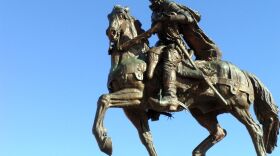Let's Talk New Mexico, 11/18 8a: The boarding school era was a dark time in U.S. history. The Albuquerque Indian School was the second-largest school of its kind in the country. So much of the history is left untold. People who survived the worst era where students were abused for speaking traditional language are no longer alive. But the effects of boarding school policies remain in public education reform efforts, systemic failures disproportionately impacting Indigenous people and generational trauma experienced by families who survived actions by the U.S. government to eradicate Native people.
The city of Albuquerque, in an effort led by Native American leaders, investigated why a park was built over a gravesite of children who attended the Albuquerque Indian School, and to educate the public on the history of the cityŌĆÖs role in the boarding school era.
On a rainy day in September, Albuquerque Mayor Tim Keller offered an apology ŌĆ£for the grievous actions over the past decades that have occurred against Native American communities right here in the city.ŌĆØ
Non-Indigenous people who live in the city can also share their opinions.
Do you know anyone that attended a Native American boarding school? Should the city of Albuquerque operate a park over a grave site? Should boarding school history be taught in public schools? And do students who arenŌĆÖt Indigenous need to know about it? Email , tweet with #LetsTalkNM, or call-in live during the show at 505-277-5866 (505-277-91░Ą═°).
More information on the . And comments can be sent to OEI@cabq.gov.
GUESTS:
- , intergovernmental tribal liaison, City of Albuquerque Office of Equity & Inclusion
- , director, City of Albuquerque Parks and Recreation
- , senior director of education and transformation, NACA Inspired Schools Network
- , instructor with Native American Community Academy
MORE INFORMATION:
- - Source NM
- - New Mexico InDepth
- - Farina King
- - CABQ.gov
- - CABQ.gov





